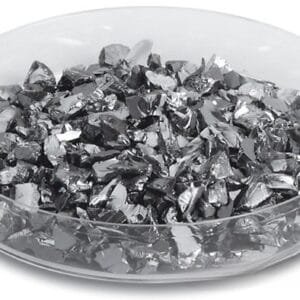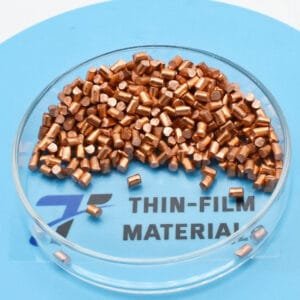Tin Evaporation Materials Description
Tin is a metallic element known for its silvery-white luster, low melting point, and flexibility. It is soft and pliable, and is chemically inert, meaning it does not react with air or water. Tin reacts slowly with dilute hydrochloric acid, and with concentrated hydrochloric acid, it forms stannous chloride. It does not react with dilute sulfuric acid but will react with concentrated hot sulfuric acid to produce tin(IV) sulfate. Additionally, concentrated hot nitric acid reacts with tin to generate β-stannic acid.
High-purity tin evaporation materials are essential for achieving superior film quality in deposition processes. TFM specializes in producing tin evaporation materials with purity levels up to 99.999%, ensuring reliability and performance through rigorous quality assurance practices.
Tin Evaporation Materials Specification
| Material Type | Tin |
| Symbol | Sn |
| Color/Appearance | Silvery Lustrous Gray, Metallic |
| Melting Point | 232 °C |
| Density | 7.28 g/cc |
| Thermal Conductivity | 66.6 W/m.K |
| Coefficient of Thermal Expansion | 22 x 10-6/K |
| Synonyms | Tin Pellets, Tin Pieces, Tin Evaporation Pellet, Sn Pellets, Sn Pieces, Sn Evaporation Pellet |
Tin Evaporation Materials Applications
- Deposition Processes: Utilized in semiconductor deposition, chemical vapor deposition (CVD), and physical vapor deposition (PVD).
- Optics: Applied in wear protection, decorative coatings, and displays.
Tin Evaporation Materials Packaging
Our tin evaporation materials are meticulously handled to prevent damage during storage and transportation, ensuring they maintain their original quality.
Contact Us
TFM provides tin evaporation materials in a variety of forms, purities, sizes, and price ranges. We are committed to producing high-purity e-beam evaporation materials with optimal density and minimal average grain sizes. For current pricing on evaporation pellets and other deposition materials not listed, please contact us with your inquiry.


 MSDS File
MSDS File



Reviews
There are no reviews yet.